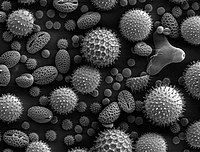
Photo from wikipedia
Revolutions in science and engineering frequently result from the development, and wide adoption, of a new, powerful characterization or imaging technique. Beginning with the first glass lenses and telescopes in… Click to show full abstract
Revolutions in science and engineering frequently result from the development, and wide adoption, of a new, powerful characterization or imaging technique. Beginning with the first glass lenses and telescopes in astronomy, to the development of visual-light microscopy, staining techniques, confocal microscopy, and fluorescence super-resolution microscopy in biology, and most recently aberration-corrected, cryogenic, and ultrafast (4D) electron microscopy, X-ray microscopy, and scanning probe microscopy in nanoscience. Through these developments, our perception and understanding of the physical nature of matter at length-scales beyond ordinary perception have been fundamentally transformed. Despite this progression in microscopy, techniques for observing nanoscale chemical processes and solvated/hydrated systems are limited, as the necessary spatial and temporal resolution presents significant technical challenges. However, the standard reliance on indirect or bulk phase characterization of nanoscale samples in liquids is undergoing a shift in recent times with the realization ( Williamson et al. Nat. Mater . 2003 , 2 , 532 - 536 ) of liquid-cell (scanning) transmission electron microscopy, LC(S)TEM, where picoliters of solution are hermetically sealed between electron-transparent "windows," which can be directly imaged or videoed at the nanoscale using conventional transmission electron microscopes. This Account seeks to open a discussion on the topic of standardizing strategies for conducting imaging experiments with a view to characterizing dynamics and motion of nanoscale materials. This is a challenge that could be described by critics and proponents alike, as analogous to doing chemistry in a lightning storm; where the nature of the solution, the nanomaterial, and the dynamic behaviors are all potentially subject to artifactual influence by the very act of our observation.
Journal Title: Accounts of chemical research
Year Published: 2018
Link to full text (if available)
Share on Social Media: Sign Up to like & get
recommendations!